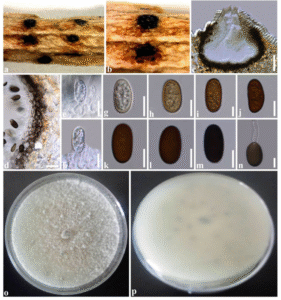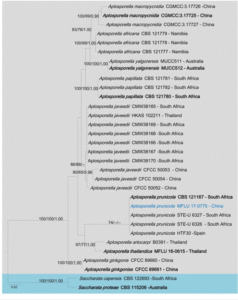Aplosporella prunicola Damm & Crous, Fungal Diversity 27(1): 39 (2007)
Index Fungorum number: IF 504373; MycoBank number: MB 504373; Facesoffungi number: FoF 04955; Fig. 1
Holotype – SOUTH AFRICA, Limpopo Province, Modimolle, from bark of small dead tree of Prunus persica var. nucipersica, 30 August 2004, U. Damm, CBS-H 19848, culture ex-type CBS 121167 = STE-U 6326; Limpopo Province, Modimolle, from the same specimen of P. persica var. nucipersica, STE-U 6327.
Saprobic on dead twig of Ficus septica Burm.f. Sexual morph: Undetermined. Asexual morph: Conidiomata 500–1000 × 200–375 μm ( x̅ = 625 × 265 μm, n = 5), pycnidial, solitary, scattered, gregarious, immersed to semiimmersed, erumpent, globose to subglobose, coriaceous, uni-loculate, dark brown to black, ostiolate. Peridium 30–40 μm wide, well developed, composed of several layers, inner two layers composed of thin-walled, hyaline, cells of textura angularis, outer three layers composed of dark brown, cells of textura angularis, becoming hyaline towards the inner region. Conidiophores reduced to conidiogenous cells. Conidiogenous cells 5–6 × 1–2 μm ( x̅ = 5.5 × 1.3 μm, n = 30), holoblastic, hyaline, cylindrical to doliiform, smooth-walled. Conidia 12–16 × 6–9 μm ( x̅ = 14.5 × 7.8 μm, n = 30), aseptate, broadly ellipsoid to subcylindrical, with rounded ends, initially hyaline, becoming brown to dark brown, smooth-walled.
Culture characteristics – Colonies on PDA reaching 25 mm diam after 2 weeks at 20–25 °C, colonies medium sparse, circular, flat, surface slightly rough with edge entire, margin well-defined, cottony to fairly fluffy with sparse aspects, colony from above: white to cream at the margin and the centre; reverse, white to grey margin and the centre; mycelium white to grey with tufting; not producing pigments in PDA.
Material examined – CHINA, Yunnan Province, Xishuangbanna, Nabanhe, dead twig of Ficus septica (Moraceae), 20 November 2015, D.S. Tennakoon, DXH 019 (MFLU 17-0775, ibid. HKAS96335), living culture, MFLUCC 16-0791.
Host and habitat – Ficus septica (Moraceae), Prunus persica and P. nucipersica (Rosaceae).
GenBank numbers – ITS: MH974684.
Notes – As phylogenetic analysis (Fig. 2) and morphological characters examined largely overlap with those of Aplosporella prunicola (Damm et al. 2007), we would like to report our collection as a new host record.

Figure 1 – Aplosporella prunicola (MFLUCC 16-0791, new host record). a Habit of conidiomata on twig. b Close-up of conidioma. c Cross section of the conidioma. d Peridium. e–f Conidiogenous cells. g–m Conidia. n Germinated spore. o Culture from above. p Culture from below. Scale bars: c–d = 20 μm, e–n = 10 μm

Figure 2 – Phylogram generated from maximum likelihood analysis of combined ITS and TEF1-α sequence data from species of Aplosporellaceae. Bootstrap support values for maximumlikelihood (ML) and maximum parsimony (MP) ≥ 65% and Bayesian posterior probabilities (PP) ≥ 0.90 are given above each branch respectively. The new isolate is in blue. Ex-type strains are in bold. The tree is rooted with Saccharata capensis (CBS 122693) and S. proteae (CBS 115206)
